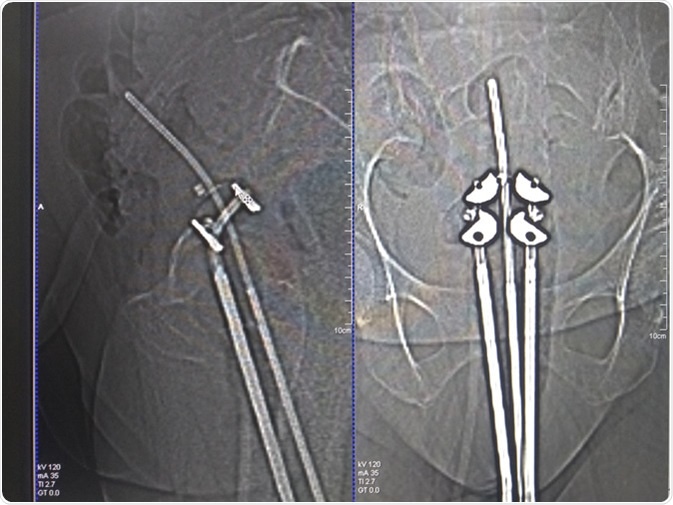Skip to:
Prostate brachytherapy (BT) is a form of radiation therapy used to treat prostate cancer. The technique involves placing encapsulated radioisotopes inside or nearby the tumor. The radioactive substances used in BT focus the radiation dose specifically to the target cancer cells. By placing the radiation close to cancer cells, less damage is conferred to the surrounding healthy tissue. To achieve the best outcome with BT, the target tissue should be clinically demarcated and accessible.
BT has proved to be an effective and safe procedure for localised cancer - it is not suitable for cancer that has metastasized or spread to the lymph nodes or to other parts of the body. It is a good alternative to prostatectomy or surgical removal of the prostate. BT can also be a treatment option for patients suffering from different concomitant diseases, especially heart disease - which is a major contraindication for surgical treatment.
BT also reduces the risk of developing long-term side effects that are commonly observed with prostatectomy. It is associated with a smaller risk of developing impotency and urinary problems. BT can be used in patients who do not want to undergo surgery due to personal preferences.
BT can be used as a monotherapy in primary tumor or as salvage treatment in recurrent cases. Salvage therapy or rescue therapy, is recommended when cancer does not respond to a standard therapy. BT can be used in combination with the external beam radiation therapy as a dose escalation tool too.

Brachytherapy applicator on CT scan. Image Credit: Chandrasekar28 / Shutterstock
How does brachytherapy work?
BT is an invasive procedure performed under sedation or anesthesia. The procedure is performed by an experienced surgeon, who is well trained with the procedure and the indications for BT.
As BT focuses the radiation dose within the cancerous area, it is possible to administer increased fractionated doses and higher biological equivalent doses. The whole procedure takes significantly less time than other treatment options.
Treating Prostate Cancer with High Dose Rate Brachytherapy
What are the types of brachytherapy?
There are two forms of prostate brachytherapy - temporary prostate brachytherapy and permanent prostate brachytherapy.
Temporary prostate brachytherapy
The temporary form of prostate BT involves placing radioactive wires in the prostate gland for a prescribed time-period (a few minutes), after which the wires are removed. This procedure may be repeated on a subsequent day. The placement of the radioactive materials is critical for the therapy to effectively treat the disease. Temporary brachytherapy may be performed as an in-patient procedure or an out-patient procedure.
In the in-patient procedure, the patient has to stay in the hospital for a specified period of time. The in-patient procedure is also known as low-dose-rate-brachytherapy.
In an out-patient setting, the patients are not admitted to the hospital; they are required to visit only during their assigned sessions. The patient undergoes several rounds of radiation treatments during these sessions. This form of BT is also termed high-dose-rate brachytherapy.
Permanent prostate brachytherapy
Permanent prostate BT involves placing radioactive implants in the prostate gland permanently, from where the radiation is gradually released over a period of time. Permanent prostate BT is also referred to as seed implantation. The time-frame for which the radioactive implant will be effective within the body depends on the half-life of the radioactive isotope used. This is because the radioactivity potential of the seeds diminishes over time.
What are the side effects of brachytherapy?
Even though prostate BT confers many benefits, it is not devoid of side effects. Prostate BT is associated with the following side effects:
- Urinary problems – This includes problems such as hematuria or blood in urine, urinary urgency, burning sensation when urinating, nocturia and incomplete bladder voiding.
- Narrowing of urethra, which is the duct that carries urine from the bladder to the exterior of the body.
- Bleeding from the rectum, which is the chamber that begins at the end of the large intestine, and ends at the anus.
- Erectile dysfunction
- Diarrhea and blood in stool
What are the contraindications for brachytherapy?
Brachytherapy is contraindicated in individuals with a life expectancy of less than 5 years. Those with previous transurethral resection of the prostate (TURP) surgery also cannot undergo BT; this is because TURP history is associated with significant urinary incontinence. Brachytherapy is also contraindicated in patients with a damaged prostate gland and recurrent hematuria.
Before BT treatment is initiated, it is important to stop anticoagulation treatment for at least a week. To get best results from brachytherapy, the volume of the prostate gland should not exceed 60 cm3 .To reduce the volume of the gland, hormone therapy can be administered few months prior to initiating brachytherapy.
Further Reading
Last Updated: Sep 11, 2019